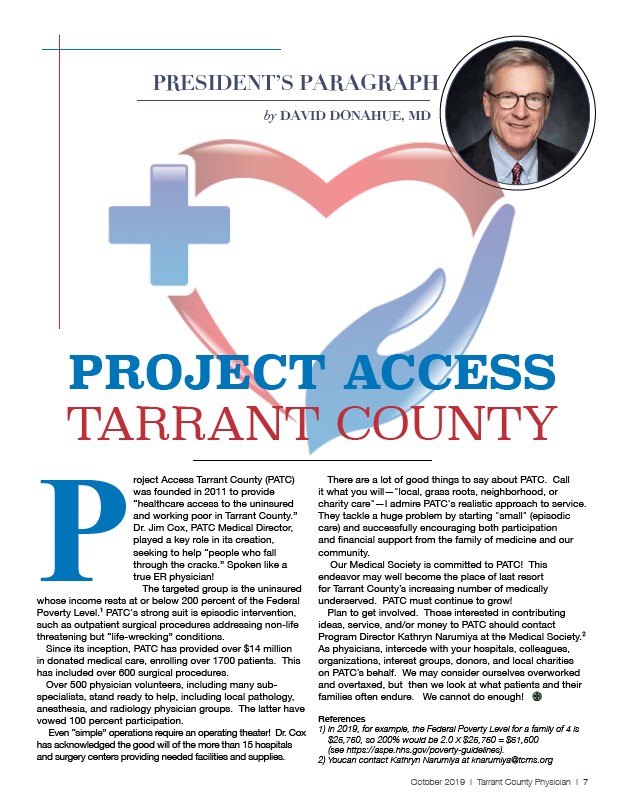
October 2019 I Tarrant County Physician I 7
roject Access Tarrant County (PATC)
was founded in 2011 to provide
“healthcare access to the uninsured
and working poor in Tarrant County.”
Dr. Jim Cox, PATC Medical Director,
played a key role in its creation,
seeking to help “people who fall
through the cracks.” Spoken like a
true ER physician!
The targeted group is the uninsured
whose income rests at or below 200 percent of the Federal
Poverty Level.1 PATC's strong suit is episodic intervention,
such as outpatient surgical procedures addressing non-life
threatening but “life-wrecking” conditions.
Since its inception, PATC has provided over $14 million
in donated medical care, enrolling over 1700 patients. This
has included over 600 surgical procedures.
Over 500 physician volunteers, including many subspecialists,
stand ready to help, including local pathology,
anesthesia, and radiology physician groups. The latter have
vowed 100 percent participation.
Even “simple” operations require an operating theater! Dr. Cox
has acknowledged the good will of the more than 15 hospitals
and surgery centers providing needed facilities and supplies.
There are a lot of good things to say about PATC. Call
it what you will—"local, grass roots, neighborhood, or
charity care"—I admire PATC's realistic approach to service.
They tackle a huge problem by starting "small" (episodic
care) and successfully encouraging both participation
and financial support from the family of medicine and our
community.
Our Medical Society is committed to PATC! This
endeavor may well become the place of last resort
for Tarrant County’s increasing number of medically
underserved. PATC must continue to grow!
Plan to get involved. Those interested in contributing
ideas, service, and/or money to PATC should contact
Program Director Kathryn Narumiya at the Medical Society.2
As physicians, intercede with your hospitals, colleagues,
organizations, interest groups, donors, and local charities
on PATC’s behalf. We may consider ourselves overworked
and overtaxed, but then we look at what patients and their
families often endure. We cannot do enough!
References
1) In 2019, for example, the Federal Poverty Level for a family of 4 is
$25,750, so 200% would be 2.0 X $25,750 = $51,500
(see https://aspe.hhs.gov/poverty-guidelines).
2) Youcan contact Kathryn Narumiya at knarumiya@tcms.org
P
PRESIDENT’S PARAGRAPH
by DAVID DONAHUE, MD
PROJECT ACCESS
TARRANT COUNTY